|
|
|
Kinamo - Model S 10 - Carl Zeiss Ikon- 1928
The camera was produced by Carl Zeiss Ikon. The first model came to the market in 1928. It was the smallest 16 mm camera at that time, on the market.
Features:
- The metal body is covered with the black leather and with nickel plated fixtures;
- Lens: Carl Zeiss Jena No 1084850;Tessar 1:2,7 f= 1,50 m; Exchangeable lens;
- The standard view finder;
- Spring motor with the speed 16 frames per second.;
- Indicator how much spring is wound up on motor;
- Film counter in foot - export to England;
- The shutter release is fitted with a lock for continuous run
- The twin sprocket film feed;
- The Zeiss Ikon magazine takes 10 meters of film;
- Tripod bush with adapter to the English thread.
Production No: W11279 /
|
|
|
|
|
|
|
|
Kinamo - Model S 10 - Carl Zeiss Ikon
It is the same model as above. The differences are:
- The Film counter in meters;
- Lens is the same model, No 866102;
- Tripod bush with continental thread.
Production No: W1052
|
|
|
|
|
|
|
|
Simplex Pockette -CC Model - 1935
The camera was manufactured by International Projector Corporation New York, N.Y.
The camera is very nice shaped, it is very thin size: 1⅛ x 4¾ x 5½ inches, and weight about 2 pounds - 1 kg.
Features:
- Construction and finish:
- The body is an aluminum alloy casing with dull silver finish, which encloses the working parts of the camera is covered with black fibroid.
- Lens : made by HugoMayer & Co Görlitz & New York No 564818; Trioplan 1:2,8 Foc. 3/4’’; It is interchangeable lens; In 1937 the lens was priced - $ 27,50. A chart indicating the proper lens settings for ordinary conditions is attached to the camera beneath the lens; Pict 5
- Viewfinder: Direct finder (on side); view finder on top, and parallax compensating optical viewfinder;

Pict 1; direct viewfinder & optical viewfinder on top; © Anna Vacani
The optical parallax viewfinder can be adjusted by turning the knurled disc so that the index marking on the face of the disc confirms to the estimated or measured distance from the object. This object will then be centered, both vertically and horizontally.
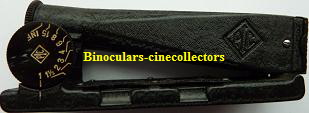 
Pict 2 & 3; optical viewfinder and top viewfinder; © Anna Vacani
- Type of loading and transit mechanism :
Special film magazine Kodak containing 50 ft. of 16 mm film; The first model 16 mm film magazine from Kodak.
The film magazine was patented. It is non-threading and film loading camera, it was outstanding features for that time.
The film magazine fits the Simplex cameras and Bell & Howell 121 Filmo camera as well; Our camera does not have the film magazine.
- Motor and mechanism : The double spring motor wound with ratchet key. Two full windings will run the entire magazine, which can be exposed at 16 and 12 pictures/sec., will be run 25 feet with one winding. The motor release gives ordinary start and stop, can be locked back. Additionally gives single picture exposure by pushing it forward and also incorporates a predetermined footage release.
The spring motor is entirely enclosed and automatically lubricated. Bearings throughout are of the self-lubricating type and require no oiling.
- Speeds: The camera speed is 16 and 12 fps. The adjustment disc is placed below the direct viewfinder - Pict 1
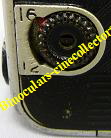
Pict 6; Speed adjustment; © Anna Vacani
The release button can be adjusted for continuous running- position “M” or single for single frame moving button to letter “S”. Pict 4
- Footage counter; the footage meter is of the subtracting kind, showing how much film is left to run, instead how much has run through; Pict 4
- Tripod bush.
Production No: CC-14606
|
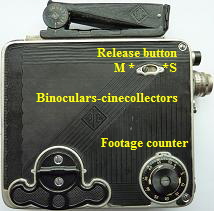
Pict 4; release button & footage counter ; © Anna Vacani
Pict 5; chart of lens settings; © Anna Vacani
|
|
|
|
|
|
|
Simplex WD - C Model 1942
This Simplex 16 mm model was sold in many variations and in many countries: Canada, England (English Patent - Ensign Simplex Pockette), Germany
Our camera was manufactured by International Projector Corporation New York, N.Y. for the War Department.
In 1953 two enthusiasts of the cameras used one of those x-Goverment 16 mm cameras to built up 3-D outfit. The experiment was described in Amateur Cine World (ACW), December 1952 edition.
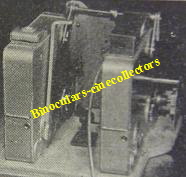
Picture from ACW - December 1953 in our collection
It is a very basic camera. On the camera is not installed, a number of mechanisms.
Construction and finish:
The main camera body is the aluminum alloy casing with blue- gray finish without any additional covers.
Many parts of the camera body are covered with metal. The part where, in this model usually are fitted:
1. side viewfinder (waist level viewfinder).
 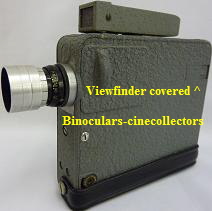
Pict 1; Simplex Pockette - side viewfinder Pict 2; Simplex WD - side viewfinder covered; © Anna Vacani
 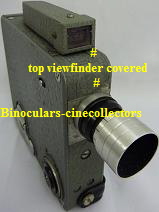 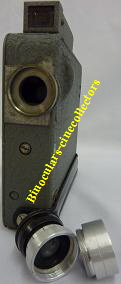
Pict3; Simplex Pockette -top viewfinder Pict 4; Simplex WD -top viewfinder - covered Pict 5; C - mount lens
© Anna Vacani
2. The chart indicating the proper lens settings below the lens is not fitted;
Lens: Bausch & Lomb Optical Co Rochester N.Y. USA; It is interchangeable lens; f : 3 - f : 16; The lens is fitted with lens hood. The lens is standard C-mount . Pict 5
Viewfinder: As it is visible in the pictures 2 and 4, the top and side viewfinders are blanked of. The optical viewfinder, fitted on top of the camera, is without an adjustment mechanism. In the front lens of this viewfinder are markings for telephoto lens field of view.
 Pict 6; Markings of the front viewfinder lens; © Anna Vacani Pict 6; Markings of the front viewfinder lens; © Anna Vacani
Type of loading and transit mechanism :
The mechanism and the film magazine is the same as in above Simplex Pockette model.
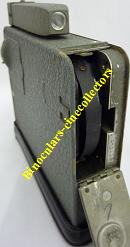
Pict 7; the film magazine chamber; © Anna Vacani
Motor and mechanism & Footage counter (Pict 4) & Speed are the same as in the Simplex Pockette model. The speed adjustment disc (Pict 2) does not have a description of the speed. However the camera is running in both speeds - 12 & 16 fps.
In accessories of the camera are two film magazine. They have the date markings in the cassettes: Feb.1 ‘42 and Feb. 2 1942
 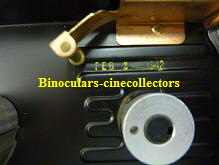
Pict 8; The markings in the film magazines; © Anna Vacani
The camera is in original case; in the Simplex Pockette catalogue - 1937 the case is named : “carrying case No. 450 for camera and three extra film magazines” - priced $ 5; The cameras model C and CC were priced $72.
Production No: C-011264
|
|
|
|
|
|
|
|
Cine - Kodak Model K - 1930
The camera was produced by Eastman Kodak Co. Rochester, N.Y., USA. The camera was manufactured from 1930 to 1946. The cameras was produced in four leather colours: black, brown, blue and gray. The cases were matching the colour of the camera.
The new camera was supplied with a dummy spool, containing 25 feet of paper instead of film. It is supplied to let the owner become thoroughly acquainted with the proper method of threading film in the camera. The ‘Cine Kodak’ films were supplied in a special container. The film could be loaded or unloaded in the daylight.
Features:
- the brown leather covered metal body with a brown case; The camera is in very good condition;
- Lens: Kodak Anastigmat F 1.9; 25 mm; 2,3,4,6,8,10,15,25,50 feet and INF. (infinity); USA PAT Nos. 1.620.337-1.690.607;
- interchangeable lens with: f 3.5 or f 4.5 - long focus lens;
- speed - 8 or 16 fps;
- exposure setting instruction around lens mount;
- winding spring motor, the spring running the motor for about 14 to 16 feet of film;
- a folding Newton finder and a waist-level finder; the direct vision finder is attached to the lens mount and is changed when the lenses are interchanged;
- loading with a 50 foot or a 100 foot ‘Cine- Kodak’ roll, placing the tension lever against the stud marked ‘50’ or ‘100’;
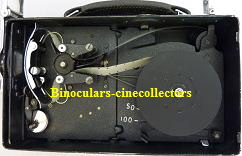 
Pict 1; Loading chamber; © Anna Vacani
- the footage counter - placed on the top of the camera (picture). It must be adjusted for each new film, moving the knurled nut until the pointer is at the star near the figure ‘100’ - for 100 ft film; or at the star near the figure ‘50’ - for 50 ft film; When the pointer comes to figure ‘0’ - the end of film is reached. Next the motor must be run until the pointer is at the line marked with a dot ‘EMPTY’, before removing the cover of the camera to unloaded it;
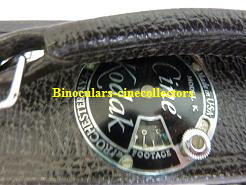
Pict 3; Cine-Kodak Model K footage; © Anna Vacani
- pressing the exposure lever down and locking it, the camera is working continuously, and when the camera is on a tripod a film maker can then steps into the picture area ;
- a tripod socket in the bottom of the camera;
Production number: 3214, very early production of that model.
|
Pict 2; Cine-Kodak Model K and accessories; © Anna Vacani
|
|
|
|
|
|
|
Cine - Kodak Model E -1937
The camera was produced by Eastman Kodak Co. Rochester, N.Y., USA; before the WWII.
This model was listed in the “Photographic Catalogue R.G. Lewis, London 1938”; printed in December 1937.
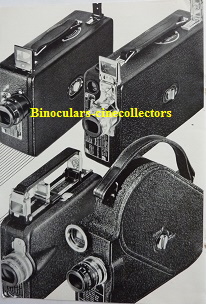 
Pictures courtesy of “Photographic Catalogue 1938” ©Anna Vacani
This is second model supplied with spool film.
This model is similar to the Cine-Kodak model E, produced from 1937. That model has a few different features - the plate in front of the camera, exposes the producer name and exposure guide, as well.
The camera was well made and is in use to this day by some enthusiasts.
Camera features;
- Construction and finished
The body construction is of die casting with a black crackle finish. The shape of the camera is different from all Cine-Kodak cameras described on this page.
 Pict 1; Cine-Kodak Model E; © Anna Vacani Pict 1; Cine-Kodak Model E; © Anna Vacani
On the camera body are placed; a plate with a camera’s name and producer of the camera (on the front camera below the lens); on the camera’s side body cover is placed exchangeable exposure calculator - depending what kind of a film is inserted into the camera. The calculator has a paper film type insert, which fits into the Cine-Kodak Universal GUIDE -visible in the picture below. The paper was supplied with Kodak films.
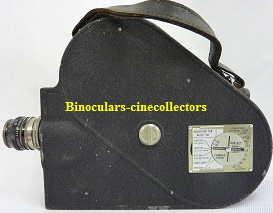 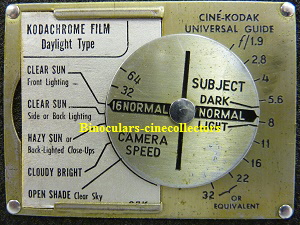
Pict 2; Cine-Kodak Model E - exposure calculator and lock button; © Anna Vacani
The camera is provided with a tripod socket in the bottom of the camera.
- Type of loading and transit mechanism
The camera is fitted with 100 ft - 30 meters film spool. It is possible to use 50 ft spool as well. The camera is design for double perforated film. If you cannot find this type of film, you have to have to remove one set of teeth on one side of the sprocket for single perforation.
The camera may be loaded or unloaded in daylight, in a subdued light.
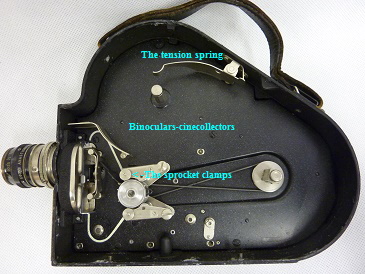 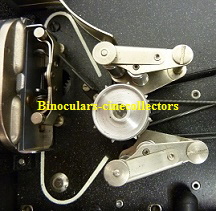
Pict 3; 4; Cine-Kodak Model E - the inside of the camera and sprocket clamps opened; © Anna Vacani
The camera is fitted with double sprockets. Loading the camera:
Pushing down the tension spring, and place the spool film on the top spindle. The tension spring is as well the footage counter arm.
Open the sprocket clamps (both of them) by pulling the knurled headed pins up and then swinging the clamps away from the sprocket. Thread the film leader between the top of sprocket and upper sprocket clamp. Next hold back the rear part of the gate (in the picture 3- parallel to the lens) and push the film into the gate. Release the handle of the gate and pull the film down in the track until the pull-down claw snaps into a perforation. Be sure that the light side of the leader is towards the lens!
Form the upper and bottom loop and at the same time thread the leader between the lower sprocket clamp and close the sprocket. When forming the lower loop, the film should follow the white line visible in the picture. These loops prevent undue strain on the pull-down and tearing of the perforations.
Thread the end of the leader into the slot in the core of the take-up spool. Wind up the film by hand turning the spool, until it is just long enough to put the spool on the take-up spindle.
Close the camera cover. If the cover does not close easily, it is because the sprocket clamps are not closed.
The camera is fitted with double footage. One is located on the side of the camera, second footage is located inside of the viewfinder. When the footage reads “0” no more pictures should be taken. Run the motor until the word “Empty” appears, before removing the cover to unload.
- Speed
The motor of this model can be operated at three different speeds: NORMAL - 16f/sec, INTERMEDIATE - 32f/sec, and SLOW MOTION - 64f/sec. To change the camera speed, move the speed indicator to the speed required.
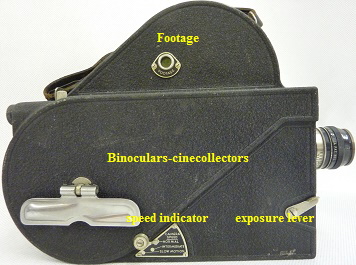 
Pict 3; 4; Cine-Kodak Model E - ; © Anna Vacani
- Motor and mechanism
The camera is fitted in spring motor. Wind up the spring by turning the key to the right (clockwise). Give it about 27 half turns or until the spring is wound tight.
- Viewfinder
The Cine-Kodak, Model E, has a fixed focus. The viewfinder consists two sections. The rear section is without adjustment.
- Lenses
Lens in our camera is Kodak Anastigmat F - 1.9; 25 mm; It is interchangeable lens; The focusing scale on the f 1,9 lens barrel is engraved for: 2, 3, 4, 6, 8, 10, 15, 25, 50 feet and INF.
Production No: 82329
|
|
|
|
|
|
|
|
Cine - Kodak Magazine 1936
The camera was produced by Eastman Kodak Co. Rochester, N.Y., USA. The camera was manufactured from 1936 to 1945.
The Cine-Kodak Magazine camera in the picture from the German “Signal “ Magazine No H7 1 April , 1941 page 17 (in our collection). The comment for the picture in Dutch language: “Under the fire of the recordings .... while the crowd were at the shot” - it was a report “ In Tyrol” .
It was first Cine-Kodak with 16 mm magazine as a replacement of film spool. The footage indicator on each magazine tells how much unexposed film remains in the magazine. The figures of the footage indicator are visible through a window in the side of the camera (see the bottom picture).
The camera has a new, for the time, system of loading the magazine. The instruction says: “to load - raise the handle on the catch to the arrow marked OPEN. Now open the door by pulling its top edge away from the camera. Slip the Magazine into the camera. The right hand end of the Magazine will be slanting upward. Close the door, when this is done the magazine will drop down into proper position. Raise the handle and slide the catch to the arrow marked LOCK”.
Features:

Pict 3; Cine-Kodak Magazine; © Anna Vacani
- Viewfinder -the viewfinder consists two sections. The rear section of the front finder is adjustable, making it suitable for all the lenses used on the Cine-Kodak Magazine. It is movable. If using the 2; 2 1/2; 3 ; 4; 4 1/2 or 6 inch lens, slide the rear section until the arrow (white in the above picture), is at the line marked for the lens being used on the camera;
- Lens in our camera - Kodak Anastigmat F - 1.9; 25 mm; It is interchangeable lens; The focusing scale on the f 1,9 lens barrel is engraved for: 2, 3, 4, 6, 8, 10, 15, 25, 50 feet and INF. The lens is coated;
- speed 16; 32 and 64; the speed adjustment is in the front of the camera - at the base;
- spring motor will run for about eleven feet of film, when fully wounded;
- the footage counter - pressing lightly on the footage window, it will pulsate automatically after each six inches of film passes through the gate;
- To compensate for parallax, two pointers are placed at the sides of the finder lens mask;
Production No: 8530 - inside the handle; 49548 on the plate at the lens.
|
Pict 1; Cine-Kodak Magazine; © Anna Vacani
Pict 2; Cine-Kodak Magazine; © Anna Vacani
Pict 4; Cine-Kodak Magazine, footage; © Anna Vacani |
|
|
|
|
|
|
Cine - Kodak Magazine 16; 1945 - the beginning of the production
The camera was produced by Eastman Kodak Co. Rochester, N.Y., USA. The camera was manufactured from 1945 to 1954. This model is only slightly changed. The first model, was produced with exposure calculator below of the lens - Look above.
New features:
- the graphic on the top plate changed

Pict 1; Cine-Kodak Magazine; © Anna Vacani
- Exposure guide is placed on the camera door side, with exchangeable guide slip, which was supplied with Kodak film;
- Lens: Kodak Anastigmat f: 1.9; 25 mm;
- The front plate is showing only the camera speed: 16; 32; 64;
- Our camera, and two 50 Ft Kodachrome magazine, was bought by the first buyer, on the 22nd January 1952, in London:
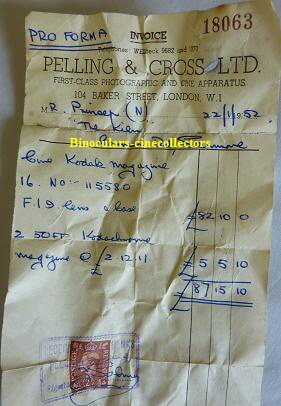
Pict 4; Cine-Kodak Magazine, invoice; © Anna Vacani
Accessories: Cine-Kodak Kodachrome color film for daylight; two lenses: Cine-Kodak Telephoto F 4.5; 3 in. made in USA by Eastman Kodak Co. Rochester, N.Y., USA.; Kodak Anastigmat F - 2.7; 2 1/2 in. made in USA by Eastman Kodak Co. Rochester, N.Y., USA.
Production No: 115580 (specified on the above invoice and on the wounding handle)
|
Pict 2; Cine-Kodak Magazine and accessories; © Anna Vacani
Pict 3; Cine-Kodak Magazine; © Anna Vacani
|
|
|
|
|
|
|
Cine - Kodak Magazine 16; 1945 - the beginning of the production
The camera was produced by Eastman Kodak Co. Rochester, N.Y., USA. The camera was manufactured from 1945 to 1954.
The camera is the same as that above.
Features:
- Lens: Kodak Anastigmat f=1,9; 25 mm; focusing; No. ES35843; coated;
The accessories:
- Two colour filters for Cine-Kodak in original black Bakelite containers;
- Cine lens adapter - Type M;
- Kodak Magazine produced for Military Ref. No 14B/3474 - in military olive-green colour and with military symbol;
- Telephoto lens with adapter: Kodak Anastigmat F-3.5; 2 In.; focusing; Made in USA by Eastman Kodak Co. Rochester NY; No 36462; uncoated;
- Two film cores.
Pict 1; Cine-Kodak Magazine; © Anna Vacani
Production No: 145043
|
|
|
|
|
|
|
|
Page Back (1) (2) (3) (4) (5)
|
|
|
|
|
|
|